Waterproofing: BASF India Ltd. – Making Wet Areas Watertight
Zoheb Mistry, Product Manager – Waterproofing and Sustainable Constructions, BASF India Limited, offers solutions for ensuring watertight systems in wet areas in drywall construction for high-rises.
 Waterproofing wet areas has always been a challenging task for the construction industry. With the introduction of the drywall concept, the construction industry is undergoing a change of materials being used to construct these wet areas. This has also created a need for reliable waterproofing systems. Current practices of waterproofing systems were originally designed for conventional brick/block masonry walls. These waterproofing systems do not serve their intended use in case of drywall panels. This article aims to provide an insight to singular component waterproofing system, which, when coupled with the correct adhesive systems, ensures a leak-free bathroom.
Waterproofing wet areas has always been a challenging task for the construction industry. With the introduction of the drywall concept, the construction industry is undergoing a change of materials being used to construct these wet areas. This has also created a need for reliable waterproofing systems. Current practices of waterproofing systems were originally designed for conventional brick/block masonry walls. These waterproofing systems do not serve their intended use in case of drywall panels. This article aims to provide an insight to singular component waterproofing system, which, when coupled with the correct adhesive systems, ensures a leak-free bathroom.
With the changing skyline, buildings are becoming more beautiful and making use of smarter materials. In such buildings, bathrooms are not just an area to clean up, but are viewed as personal spaces to get refreshed and rejuvenated. This calls for use of different building materials. Drywall panels are one such component, which are gradually becoming the material of choice in the construction of bathroom walls.
Use of drywall panels is advantageous to developers, but it is important to ensure the water tightness of these areas and still accommodate movement that would occur in these panels. Also, repairs in such areas can be a nightmare for owners as they can be extremely costly, and a lengthy and a disruptive process. Hence, it is important to use the correct systems to ensure a defect-free and durable structure.
Solutions
Single component, waterproof and flexible coating, MasterSeal 561, from BASF Master Builder brand, can be the perfect solution for under ceramic coverings in showers and bathrooms. Unlike traditional cementitious waterproofing systems, MasterSeal 561 not only has higher elongation properties (to accommodate movement at joints), but also allows the tiles to be laid directly over it. The solution saves time and cost for an overlay for protection before the tiling activity commences.

MasterSeal 561 is the right fit for moisture sensitive substrates like plaster, Gypsum blocks, fiber boards, and particle boards. As the system is ready to use, it ensures minimal dependency on a worker for mixing of multiple components, and thereby, eliminating chances of error during application.
Coupled with special waterproofing tapes such as PCI Pecitape for the joints and PCI Pecitape Gaskets for the pipe penetrations and drain cut outs, the bathroom can be made completely water tight.
For application over sensitive substrates, such as drywall panels, it is advisable to adopt a holistic waterproofing approach, which includes tile adhesive as well. The MasterSeal Wet Area systems ensure a defect-free, durable, water-tight structure.

With the changing skyline, buildings are becoming more beautiful and making use of smarter materials. In such buildings, bathrooms are not just an area to clean up, but are viewed as personal spaces to get refreshed and rejuvenated. This calls for use of different building materials. Drywall panels are one such component, which are gradually becoming the material of choice in the construction of bathroom walls.
Use of drywall panels is advantageous to developers, but it is important to ensure the water tightness of these areas and still accommodate movement that would occur in these panels. Also, repairs in such areas can be a nightmare for owners as they can be extremely costly, and a lengthy and a disruptive process. Hence, it is important to use the correct systems to ensure a defect-free and durable structure.
Solutions
Single component, waterproof and flexible coating, MasterSeal 561, from BASF Master Builder brand, can be the perfect solution for under ceramic coverings in showers and bathrooms. Unlike traditional cementitious waterproofing systems, MasterSeal 561 not only has higher elongation properties (to accommodate movement at joints), but also allows the tiles to be laid directly over it. The solution saves time and cost for an overlay for protection before the tiling activity commences.

MasterSeal 561 is the right fit for moisture sensitive substrates like plaster, Gypsum blocks, fiber boards, and particle boards. As the system is ready to use, it ensures minimal dependency on a worker for mixing of multiple components, and thereby, eliminating chances of error during application.
Coupled with special waterproofing tapes such as PCI Pecitape for the joints and PCI Pecitape Gaskets for the pipe penetrations and drain cut outs, the bathroom can be made completely water tight.
For application over sensitive substrates, such as drywall panels, it is advisable to adopt a holistic waterproofing approach, which includes tile adhesive as well. The MasterSeal Wet Area systems ensure a defect-free, durable, water-tight structure.
NBM&CW April 2018


















